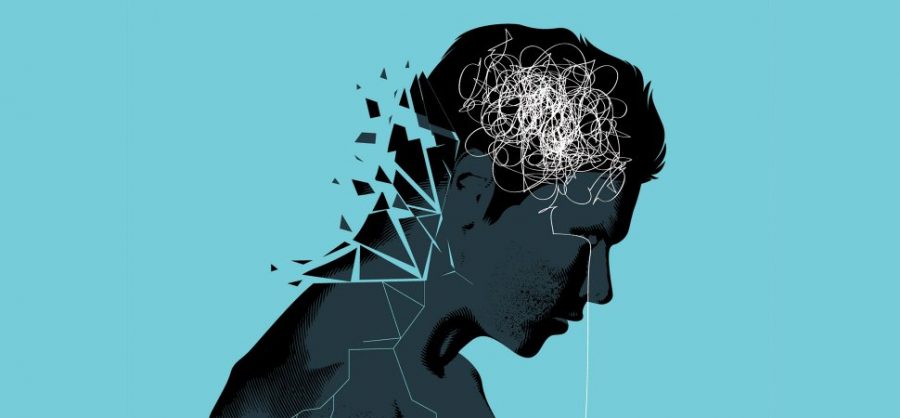
Stress, poverty, genetics, anxiety, suicide, mass shootings, behavioral disorders, depression, sexual/gender identity, trauma, and school discipline policies. These are some of the known causes and effects of mental health issues in American High schools. The number of affected students has been and is increasing, creating serious problems for today’s and tomorrow’s youths. These disorders can leave teens a lifetime of not only mental problems but physical problems because mental health affects the body as well as the brain.

Depression and Anxiety
The most widely known mental disorders are depression and anxiety, and they are the most common among adolescents, with 16.5% of children being diagnosed every year. Anxiety and depression lead to social/behavioral issues, along with mental issues, such as: poor performance, learning issues, low self-image, unpredictable behaviors, bad hygiene, and poor self-care.
The signs of these disorders are hard to identify, but the mayo clinic states some signs in a bullet list, as follows:
Loss of interest in, or conflict with, family and friends
Low self-esteem
Extreme sensitivity to rejection or failure, and the need for excessive reassurance
Trouble thinking, concentrating, making decisions and remembering things
Tiredness and loss of energy
Insomnia or sleeping too much
Changes in appetite — decreased appetite and weight loss, or increased cravings for food and weight gain
Poor school performance or frequent absences from school
Less attention to personal hygiene or appearance
Self-harm — for example, cutting, burning, or excessive piercing or tattooing
Depression and anxiety can be caused by many factors such as fear/worrying over the past present and/or future, past traumas, or the teen feeling despair over mistakes. Noticing the signs are crucial for the affected victims because when gone unnoticed, the disorders could permanently damage or end a life.
Suicide
Suicide is the 2nd leading cause of death for people aged 10-24 (https://www.childtrends.org/), with more teens dying from suicide than cancer, Aids, influenza, birth defects, and stroke combined. The people who succumb to suicide often feel like they have no other option, but 4 out of 5 teens who attempt suicide give off clear warning signs of mental illness.
With the suicide rate of 10-24-year-olds rising by 56% in the last decade, it is vital that these signs don’t go unnoticed or ignored. If you or a person you know is showing signs of suicidal tendencies/ ideation please call the suicide prevention lifeline at (1-800-273-8255).
Schizophrenia
Schizophrenia is a mental illness: “characterized by incoherent or illogical thoughts, bizarre behavior and speech, and delusions or hallucinations, such as hearing voices.”(https://www.apa.org) This disorder is hard to spot, as its signs overlap with depression, anxiety, and “normal” teenage moodiness. Schizophrenia is not often seen in children, as it usually develops in late adolescence to early adulthood. The signs evolve rapidly. Here are some from( https://www.webmd.com).
Lack of concentration or being able to follow a train of thought
Seeing or hearing things that aren’t real (hallucinations)
Confusing TV and dreams with reality
Paranoia — thinking that people are after them or talking about them
Being extremely moody or irritable
Angry outbursts
Severe fearfulness
inappropriate responses, such as laughing during a sad movie
Trouble “reading” social cues in others
Becoming more and more isolated
Poor personal grooming and self-care
If a teen is showing symptoms of schizophrenia, contact a doctor. The teen will be given a questionnaire and a physical exam. With the possibility of urine/blood tests to rule out any drug abuse or other medical conditions.
Bipolar Disorder
“Bipolar disorder is a serious mental illness in which common emotions become intensely and often unpredictably magnified. Individuals with bipolar disorder can quickly swing from extremes of happiness, energy, and clarity to sadness, fatigue, and confusion.”(https://www.apa.org) People with Bipolar disorder experience episodes of manic, energetic, happy episodes, and depressive episodes. These “swings” are also known as mood episodes. Bipolar disorder, like schizophrenia, often develops during late adolescence to early adulthood. This disorder has a wide range of symptoms, due to the extreme contrasting emotions faced by the affected person. These symptoms will be identified as either manic or depressive, from (https://www.nimh.nih.gov):
Manic:
Feel very happy or act silly in a way that’s unusual for them and for other people their age
Have a very short temper
Talk really fast about a lot of different things
Have trouble sleeping but not feel tired
Have trouble staying focused
Talk and think about sex more often
Do risky things
Depressive:
Feel very sad
Complain about pain a lot, such as stomachaches and headaches
Sleep too little or too much
Eat too little or too much
Have little energy and no interest in fun activities
Think about death or suicide
If you know a child might be going through bipolar disorder, please take them to a doctor for a diagnosis. The process doesn’t require any invasive testing but has a questionnaire for the adolescent to complete regarding their emotions and sleep patterns.
Borderline Personality Disorder
Borderline personality disorder, or BPD, is a complex mental disorder comparable to Bipolar disorder, with the difference that BPD is a personality disorder while Bipolar disorder is a mood disorder. The person who has this disorder usually sees the world and its contents in extremes (good or bad), these views can change rapidly, leading to unstable relationships when intense opinions of people are shifted.
Borderline personality disorder patients often have poor impulse control, and the affected people often take part in dangerous activities such as overspending whilst shopping, unsafe sex, eating disorders, drug or alcohol abuse, or reckless driving. The impulsivity of BPD patients is the most notable of symptoms, but (https://www.nimh.nih.gov) compiled a list of less notable signs, including but not limited to:
A pattern of intense and unstable relationships with family, friends, and loved ones, often swinging from extreme closeness and love (idealization) to extreme dislike or anger (devaluation)
Distorted and unstable self-image or sense of self
Self-harming behavior
Recurring thoughts of suicidal behaviors or threats
Intense and highly changeable moods, with each episode lasting from a few hours to a few days
Chronic feelings of emptiness
Inappropriate, intense anger or problems controlling anger
Difficulty trusting, which is sometimes accompanied by an irrational fear of other people’s intentions
Feelings of dissociation, such as feeling cut off from oneself, seeing oneself from outside one’s body, or feelings of unreality
Adolescents who partake in these actions should be brought to or seek medical help. The diagnosis of BPD is a process analysis of the teen’s actions and the reasons behind them. If a teen acts in risky ways in order to escape his or her own feelings, it shows the teen cannot handle their emotions and is looking for a way around them.
The treatments for Borderline personality disorder are evidence-based. They include therapies like dialectical behavior therapy (DBT) where a teen focuses on learning skills for handling their emotions and relationships, with an emphasis on the “development of four skill sets: mindfulness, interpersonal effectiveness, emotion regulation, and distress tolerance.” (https://www.mcleanhospital.org) Other therapies like mentalization-based treatment (MBT) and general psychiatric management (GPM) help the teen separate their feelings from others.
Obsessive-Compulsive Disorder
Obsessive-compulsive disorder (OCD) is a mental illness characterized by its patients having Impulsive thoughts, unreasonable fears, or obsessions that lead to compulsive behavior. OCD is stigmatized about people having a fear of germs, or who are anal about keeping their spaces clean/ organized. The truth is OCD, makes people anxious or obsessive about any routine or pattern they come across. The symptoms are easy to spot, and the most common in teens include:
Repeating rituals, including going in and out of doorways, needing to move through spaces in a special way, or rereading, erasing, and rewriting
Checking rituals to make sure that the appliances are off or a door is locked, and repeatedly checking homework
Rituals to undo contact with a “contaminated” person or object
Touching rituals
Rituals to prevent harming self or others
Ordering or arranging objects
Counting rituals
Hoarding and collecting things of no apparent value
The diagnosis of OCD is an analysis by a medical professional, that includes tests to rule out any overlapping or underlying problems. The teen will most likely be referred to take medication and/or attend psychotherapy.
Send off
Being a teenager isn’t easy: physically, emotionally, sexually, mentally and hormonally. These changes in life can be overwhelming and lead to many mental issues, it is up to the surrounding adults and peers to spot symptoms of these issues and help the affected seek treatment. Treatment is vital for these people, as mental health isn’t just a concern, it can be life-ending.
Vocabulary
Behavioral disorders: refers to a category of mental disorders that are characterized by persistent or repetitive behaviors that are uncommon among children of the same age, inappropriate, and disrupt others and activities around the child.
Sexual/gender identity: One’s innermost concept of self in regards to attraction and gender
Depression: feelings of severe despondency and dejection.
Anxiety: a feeling of worry, nervousness, or unease, typically about an imminent event or something with an uncertain outcome.
Schizophrenia: a long-term mental disorder of a type involving a breakdown in the relation between thought, emotion, and behavior, leading to faulty perception, inappropriate actions and feelings, withdrawal from reality and personal relationships into fantasy and delusion, and a sense of mental fragmentation
Hallucinations: an experience involving the apparent perception of something not present
Bipolar disorder: a mental condition marked by alternating periods of elation and depression.
Manic: frenetically busy; frantic
Borderline personality disorder: A mental disorder characterized by unstable moods, behavior, and relationships.
Idealization: the action of regarding or representing something as perfect or better than in reality.
Devaluation: the reduction or underestimation of the worth or importance of something.
Dissociation: disconnect or separate (used especially in abstract contexts).
Obsessive-compulsive disorder: having a tendency towards excessive orderliness, perfectionism, and great attention to detail.
Psychotherapy: the treatment of mental disorder by psychological rather than medical means.